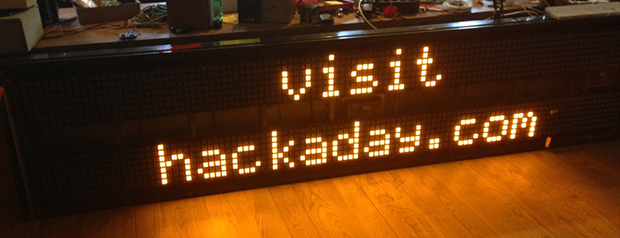
In a fit of awesome salvaging, [Piet] picked up a huge, 16 character, 2 line display. It’s monstrous, designed for outdoor installations; road signs, train stations, and the like. It also draws 23 Watts when nothing is being displayed, making this the perfect piece of salvaged equipment to reverse engineer.
The display was originally connected to a computer running proprietary software. The protocol between the display and computer is also proprietary, giving [Piet] the choice of either reverse engineering the protocol, or reverse engineering the hardware and building a new driver board. For anyone with a soldering iron, the second option is the simplest.
Disassembling the display, [Piet] found each character in the display was its own board with a 7×14 array of pixels, each with four LEDs. The rows and columns of each character are addressed with a shift register, and with an Arduino, [Peit] got a single character working.
The Arduino would struggle to display all the characters in the display, so a Raspi was pulled out, a driver and frame generator written, and the whole thing connected to Twitter It’s a beautifully display that draws 200 Watts when its scanning the pixels, and a wonderful reuse of disused hardware. Video below.















No scrolling messages from Colossus?
+1 for the Forbin Project. I loved that movie
Yeah i still like it too. While the tech in that movie may have gotten dated looking, Even watching it just a few months ago, the premise still has the ability to give me the willies.
Given what we knew of things in that era, I’ve always felt it was pretty decently thought out and written.
I slightly wonder what an R rated version might have been like
But quite likely the strictures of a G rating gave us a bit more expressive, thoughtful writing.
Got one with a single line here, should work on it again :/
How exactly does this draw so much power when nothing is being displayed? Poor design?
Probably loads of TTL shift register chips… Not that bad, it keeps the inside warm which is required when it is used outdoors. There may also be a dedicated heating resistor.
I hadn’t thought of that. Would an LED display need to be that warm though?
They probably manufacture them for clients globally, or at least across the US. That would mean that it’d need to operate in conditions like Alaska winters, and a simple heating element is cheaper when manufacturing than a thermostat (even if it ups the running costs)
This one was made for the Belgian market. So no extreme wether conditions here. I also checked for a heating resistor, but couldn’t find one.
What harm would it do if the box got cold though? ICs, transistors, LEDs, they’re all fine well below 0C. I can’t see why they’d need heaters.
Heating eliminates condensation issues inside the cabinet.
Also in case of snow, the snow will not pile up on the top of the display… I know at least one case where they had to add additional heating to a led display to prevent from being buried under snow.
Not everything works as expected below 0C. Electrolytic caps, crystals performance are affected by low temperature. I remember one of the rep for a company that screen parts for extended temperature talked about the test they are doing for (dynamic) memory.
There is also the condensation, temperature cycling (to solder joints) issues. Some of the new LED traffic lights are having those issues in cold areas because they don’t generate enough heat.
If the display is consuming 200W full on, I would guess that they wouldn’t worry too much about 23W.
@RP is right, condensation is a real pain and a bugger to diagnose.
Also known as ‘how to get water damage in something that doesn’t even get rained on’.
Oh! Nice LED display works with a tweet.. :)